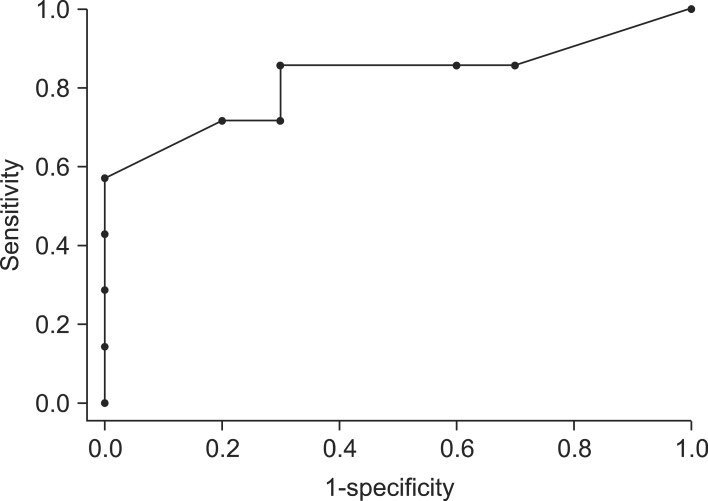Korean J Hepatobiliary Pancreat Surg.
2014 Feb;18(1):9-13. 10.14701/kjhbps.2014.18.1.9.
Analysis of gallbladder polypoid lesion size as an indication of the risk of gallbladder cancer
- Affiliations
-
- 1Department of Surgery, Ulsan University Hospital and University of Ulsan College of Medicine, Ulsan, Korea. drcwnam@hotmail.com
- KMID: 1890074
- DOI: http://doi.org/10.14701/kjhbps.2014.18.1.9
Abstract
- BACKGROUNDS/AIMS
Recent advances in ultrasonography have contributed to the early detection of gallbladder cancer. We attempted to predict the progression of the disease by comparing the sizes of polypoid lesions, and we suggest that the size of the lesion would be a useful guideline to determine an appropriate primary surgical approach for polypoid lesions of the gallbladder.
METHODS
We have retrospectively analyzed 253 patients that, during the operation period from January 2009 to December 2011, had had ultrasonographically detected gallbladder polypoid lesions, and who underwent cholecystectomy at Ulsan university hospital. We have analyzed the demographic data of the patients, the preoperative size of polypoid lesions, and pathologic findings.
RESULTS
Of a total of 253 patients, 235 patients had benign lesions, and 18 patients had malignant lesions. Among the malignant polyp patients, 11 had pT1 cancer, 6 had pT2 cancer, and 1 had pT3 cancer. The average size of polypoid lesions was 9.1+/-3.1 mm and that of malignant lesions was 28.2+/-16.4 mm. The receiver operating characteristic (ROC) curve of the benign and malignant groups shows that 14.5 mm is the optimal point of prediction of the malignancy. Of a total of 18 patients of GB cancer, 11 had pT1 and the average size of their polypoid lesions was 20.5+/-5.8 mm 7 had pT2 with a size of 39.1+/-20.7 mm. ROC curve analysis of the pT1 and pT2 groups shows that 27 mm would be the optimal point to predict T2 and above cancer.
CONCLUSIONS
In the case of an early cancer, curative treatment can be achieved through a simple and minimally invasive laparoscopic cholecystectomy. We attempted to predict early cancer occurrence among polypoid lesions of the gallbladder using the simplest standard, size. Although there are some limitations, size can be a simple and easy way to evaluate polypoid lesions of the gallbladder.
Keyword
MeSH Terms
Figure
Reference
-
1. Choi SB, Han HJ, Kim CY, et al. Incidental gallbladder cancer diagnosed following laparoscopic cholecystectomy. World J Surg. 2009; 33:2657–2663. PMID: 19823903.
Article2. Zhang WJ, Xu GF, Zou XP, et al. Incidental gallbladder carcinoma diagnosed during or after laparoscopic cholecystectomy. World J Surg. 2009; 33:2651–2656. PMID: 19760311.
Article3. Varshney S, Butturini G, Gupta R. Incidental carcinoma of the gallbladder. Eur J Surg Oncol. 2002; 28:4–10. PMID: 11869005.
Article4. Goetze TO, Paolucci V. Adequate extent in radical re-resection of incidental gallbladder carcinoma: analysis of the German Registry. Surg Endosc. 2010; 24:2156–2164. PMID: 20177938.
Article5. Cho YK, Park CY, Shin JH. A surgical consideration on gallbladder polyp-a proposal of therapeutic guideline for gallbladder polyp-. Korean J Gastroenterol. 2002; 39:415–419.6. Park JK, Yoon YB, Kim YT, et al. Management strategies for gallbladder polyps: is it possible to predict malignant gallbladder polyps? Gut Liver. 2008; 2:88–94. PMID: 20485616.
Article7. Christensen AH, Ishak KG. Benign tumors and pseudotumors of the gallbladder. Report of 180 cases. Arch Pathol. 1970; 90:423–432. PMID: 4319984.8. Yeh CN, Jan YY, Chao TC, et al. Laparoscopic cholecystectomy for polypoid lesions of the gallbladder: a clinicopathologic study. Surg Laparosc Endosc Percutan Tech. 2001; 11:176–181. PMID: 11444747.9. Bang S. Natural course and treatment strategy of gallbladder polyp. Korean J Gastroenterol. 2009; 53:336–340. PMID: 19556839.
Article10. Roa I, de Aretxabala X, Araya JC, et al. Preneoplastic lesions in gallbladder cancer. J Surg Oncol. 2006; 93:615–623. PMID: 16724345.
Article11. Kozuka S, Tsubone N, Yasui A, et al. Relation of adenoma to carcinoma in the gallbladder. Cancer. 1982; 50:2226–2234. PMID: 7127263.
Article12. Myers RP, Shaffer EA, Beck PL. Gallbladder polyps: epidemiology, natural history and management. Can J Gastroenterol. 2002; 16:187–194. PMID: 11930198.
Article13. Shin SR, Lee JK, Lee KH, et al. Can the growth rate of a gallbladder polyp predict a neoplastic polyp? J Clin Gastroenterol. 2009; 43:865–868. PMID: 19398929.
Article14. Lee KF, Wong J, Li JC, et al. Polypoid lesions of the gallbladder. Am J Surg. 2004; 188:186–190. PMID: 15249249.
Article15. Corwin MT, Siewert B, Sheiman RG, et al. Incidentally detected gallbladder polyps: is follow-up necessary?--Long-term clinical and US analysis of 346 patients. Radiology. 2011; 258:277–282. PMID: 20697115.
Article16. Terzi C, Sökmen S, Seçkin S, et al. Polypoid lesions of the gallbladder: report of 100 cases with special reference to operative indications. Surgery. 2000; 127:622–627. PMID: 10840356.
Article17. Kim MS, Sim MS. Operative criteria for polypoid lesions of the gallbladder. J Korean Surg Soc. 1999; 57:107–113.18. de Groen PC, Gores GJ, LaRusso NF, et al. Biliary tract cancers. N Engl J Med. 1999; 341:1368–1378. PMID: 10536130.
Article19. Whalen GF, Bird I, Tanski W, et al. Laparoscopic cholecystectomy does not demonstrably decrease survival of patients with serendipitously treated gallbladder cancer. J Am Coll Surg. 2001; 192:189–195. PMID: 11220719.
Article20. Muratore A, Polastri R, Capussotti L. Radical surgery for gallbladder cancer: current options. Eur J Surg Oncol. 2000; 26:438–443. PMID: 11016462.
Article
- Full Text Links
- Actions
-
Cited
- CITED
-
- Close
- Share
- Similar articles
-
- Laparoscopic Cholecystectomy for Polypoid Lesions of the Gallbladder
- Surgical Guideline of Polypoid Lesions of Gallbladder
- Clinicopathological Significance for Polypoid Lesions of the Gallbladder: The Adenoma-carcinoma sequence
- Cholelithiasis as a Risk Factor for Gallbladder Cancer
- Polypoid Lesions of Gallbladder: Clinicopathological Features and Indication of Operation



